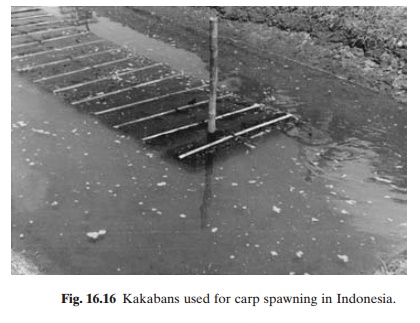Chapter: Aquaculture Principles and Practices: Carps
Spawning and larval rearing - Spawning and fry production of Carps
Spawning and larval rearing
Spawning of common carp can be carried out in spawning ponds or in a
hatchery, using induced spawning methods. Obviously pond spawning is easier for
farmers, especially when they do not have the necessary hatchery facilities.
However, induced spawning and hatchery rearing of larvae provide greater
control over the propagation procedures and greater survival rates of larvae
when reared in indoor tanks. Spawning can be carried out in small or large
ponds, although smaller ponds are easier to manage. It is possible to spawn
common carp in cement cisterns or even in cloth tanks (hapas), but then the
fertilized eggs or early larvae will have to be transferred to nursery tanks or
ponds.
There are different types of substrates or egg collectors used in carp
spawning ponds. Mats made of fibres of the indjuk (Arenga spp.), known as ‘kakabans’ in Indonesia, are commonly used
now by many farmers. Half to one metre long fibres are arranged in the form of
a 40–70cm mat, pressed longitudinally between two bamboo lathes. They are
placed on long bamboo poles held in place between two pairs of shorter poles
driven into the bottom (fig. 16.16). The mat remains slightly submerged, but
floats with the bamboo pole and adjusts itself to changes in the water level.
Water weeds such as Ceratophyllum and
Myriophyllum, kept in place within a
bamboo frame, are also used by some farmers in Asia. Israeli farmers use
branches of pine, casuarina or cypress as egg collectors.

Artificial spawning mats made of synthetic material can also be used.
The mat area needed as substrate is about 10m2 for every 2–3kg females. The
spawning mats are easy to handle and it is easy to estimate the number of eggs
spawned. If only the underside of the mat has been used by the fish for
depositing eggs, the mat can be turned over for deposition of more eggs. Such
spawning mats can be placed in cement cisterns or cloth tanks (hapas) installed
in ponds, filled with fresh clean water from a natural source, for incubation
and hatching of eggs.
It is essential to ensure that the water supply to the spawning pond is from a natural source and not from another fish pond where large numbers of fish are held. The importance of fresh water in triggering
spawning has already been mentioned. Ripe spawners from the segregation ponds
are released into the spawning pond after it is filled. The number of spawning
females (2–5kg weight) introduced per hectare of pond area is about 10, and the
ratio of females to males is about 2:3. Weight-wise the ratio may often be 1:1,
as the males are smaller in size and weigh less. The ripe fish generally spawn
in the morning after they are introduced into spawning ponds or tanks.
In Israel, where fish culturists often spawn fish late in the season (by
August) to prevent the progeny from maturing and spawning before reaching
market size during the succeeding spring, the brood fish are injected with
pituitary extract to stimulate spawning. Females are injected with one
pituitary per kg body weight and the males with half that dose. The number of
eggs in late season is much smaller and so a larger number of females is
introduced per hectare of spawning pond – as many as five to seven times the
usual number.
The incubation period of eggs depends on temperature conditions, varying
from 7 to 7.5 days at 16–17°C to 2 days at 30°C. The temperature most suited
for hatching is considered to be 20–22°C or 60–70 day-degree (Woynarovich and
Horvath, 1980).
Related Topics